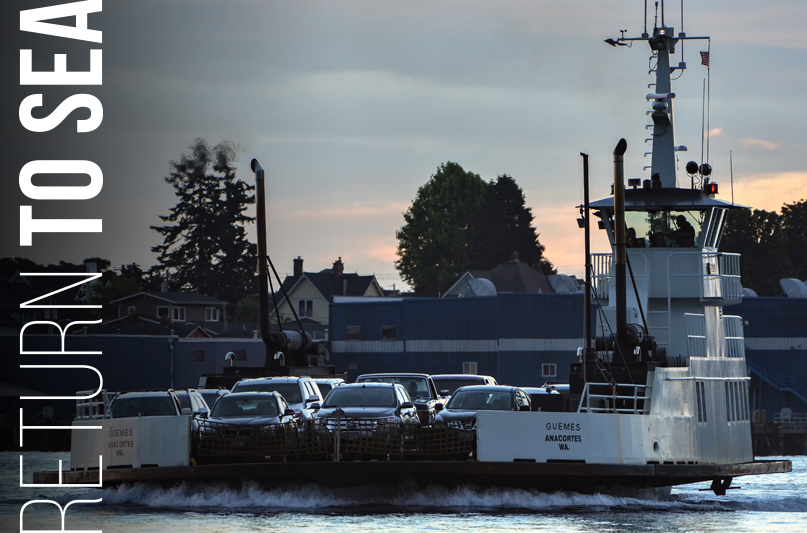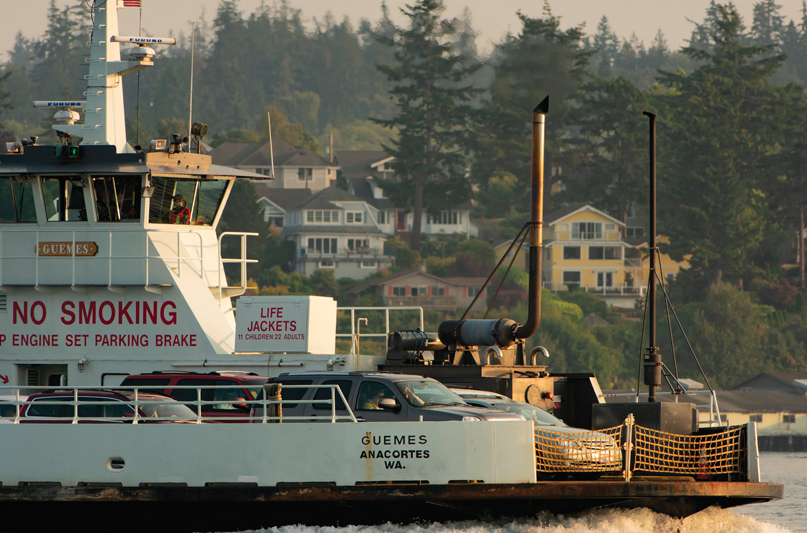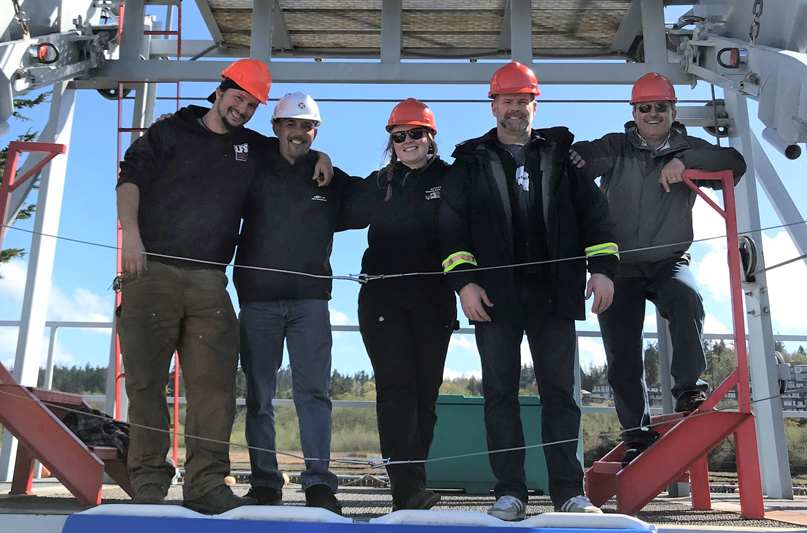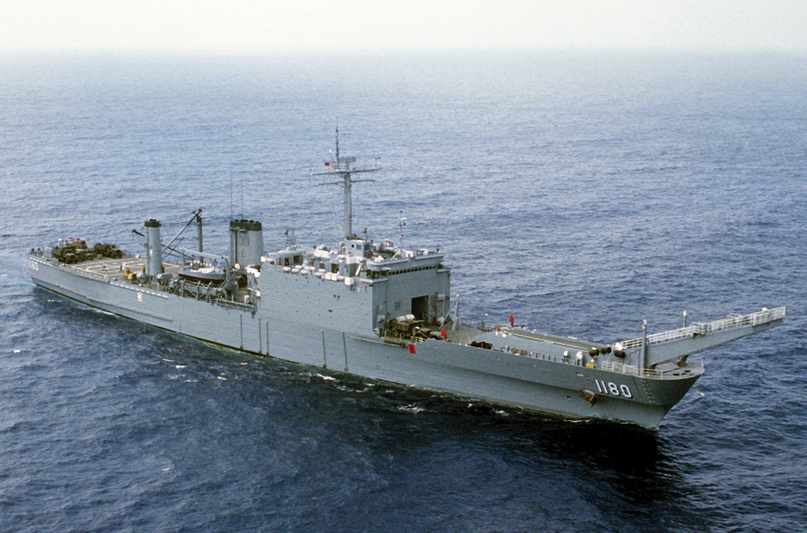
 Four crewmembers and I are in the water, buoyed by our immersion suits, linked arm in arm, while a sixth shipmate rights the life raft so we can climb aboard to relative safety and await rescue.
Four crewmembers and I are in the water, buoyed by our immersion suits, linked arm in arm, while a sixth shipmate rights the life raft so we can climb aboard to relative safety and await rescue.
For some, this is the first time in an immersion suit and the jump into the water is a leap of faith – like jumping off a concert stage into a mosh pit and trusting that the crowd is going to catch you. You can’t swim in an immersion suit; you have to trust that it will keep you and your head above water, as it is designed to do.
Once in the water, we maneuver into a circle and lock arms to keep each other from drifting away. Linked together, we kick to arrive at the raft as a group and climb aboard one by one.
This effort would be different in rough seas, and we knew it. That day in a swimming pool in Shoreline, a suburb of Seattle, we were participating in the Basic Safety Training course offered by Compass Courses Maritime Training School, a woman-owned business and one of three private maritime schools in the United States with its own on-site davit for lifeboat training.
Among this diverse group was a dive instructor transitioning to a career as an able seaman aboard the M/V Coho, which carries vehicles and passengers between Port Angeles and Victoria; a 20-something charter yacht sailor who wants to work on a National Oceanic and Atmospheric Administration (NOAA) research vessel; a purser on a cruise ship attaining her mate’s license; a former political science student who was lured away from academia by the sea; and me, a former quartermaster and helmsman in the U.S. Navy during President Ronald Regan’s term. I am returning to the sea after a 33-year-career in journalism.
At age 56, I’m the oldest able seaman, or AB, in the group. AB is the naval rating of someone who has more than two years of experience at sea and works on a merchant ship. In a period of three weeks, I studied aids to navigation, rules of the road, deck and deck safety, marlinespike seamanship, ship structure and construction, personal survival techniques, basic shipboard firefighting, first aid and CPR, personal safety and social responsibilities, lifeboats and other survival craft, oar commands, shipboard preparation, planning, and handling emergencies, heavy weather, and rescues.

Cram courses, perhaps. But our instructor Chuck Spence, a retired Navy senior chief and Merchant Marine officer, still expected us to know how to correctly figure out in our heads the force needed to lift 948 lbs. using a double luff tackle rigged to disadvantage, and the breaking strength of 3″ nylon line.
At each class, I was waiting for someone to call me “Pops,” but it turns out I’m within the average age of merchant mariners, according to my instructors. There is no romantic view of life at sea among those with whom I’ve studied. Each is a dedicated mariner that recognizes the awesome responsibility that comes with an AB ticket or a mate or master’s license.
According to the International Chamber of Shipping in London, England, merchant mariners in more than 150 nations are responsible for the delivery of around 90 percent of world trade. In the U.S., there are 175 privately owned, oceangoing vessels of 1,000 gross tons and above that carry cargo from port to port. In addition, U.S. merchant mariners operate charter and excursion boats, dredges, ferries, research vessels, towboats, and tugboats. During war, merchant mariners transport equipment, supplies, and troops; and many mariners have paid the ultimate price. During the Second World War, some 1,554 merchant ships were sunk and an estimated 9,521 merchant mariners were killed, according to the National Archives.
This is the legacy we carry. And Compass Courses – whose slogan is “Train Like You Give A Damn” – works to produce graduates for whom safety and seamanship are second nature. Spence pushes his students hard (prudent students practice their knots on breaks). Sure, you can get 70 percent of your exam answers correct and pass the course, but consider this: “On the water, you’ve got to be correct 100 percent of the time,” Spence says. “Make one mistake, and you don’t get to ask, ‘What about all the other times I got it right?’” Spence once kept me after class until he was satisfied I could tie a French bowline within a specified time.

In our class on operating a lifeboat davit, retired Navy first class petty officer Dave Richards opens with a video showing what happens when a lifeboat is not properly secured. According to several industry sources, several mariners are injured or killed annually in lifeboat drills. The causes include unsafe practices during drills and inspections, communication failures, inadequate maintenance of the release system, inadequate training, lack of familiarity with system and controls, and failure or inadvertent operation of the release mechanism. By the end of our course, all hands will know each step as if someone’s life depends on it—because it does.
Ditto for all operations of the vessel. Rob Scott is an ordinary seaman aboard the Washington State Ferries, the nation’s largest ferry system. “People are relying on you to get them to their destination safely,” he says. “When you finish the trip, there’s a sense of accomplishment that leads you to the next job.”
In the state ferry fleet, crew members drill every week. “Situations can happen,” Scott says. “That’s why we drill — abandon ship, rescue, fire – so if something does happen, everybody knows their job.”
Before working on the ferries, Scott was a yacht captain who delivered boats to Hawaii and Mexico. Today, he and his wife also own Sogno di Vino, a fine restaurant in downtown Poulsbo. Working on the ferries “satisfies the need” he has to be on the water.
“I like the predictability of the ferries,” he says. Unlike sailboats, he quips, “you’re not going to get wet and there’s no risk of tipping over.”
There’s that, but I know what he means about the need. My experiences at sea have shaped me as a human being, inspired me, and fed my soul. I’ve steered a Navy tank landing ship into battle-torn Beirut at 0-dark-thirty, the conning officer navigating us past fishing boats in the harbor en route to landing U.S. Marines as part of a multinational peacekeeping force. The attention to detail that became part of my DNA in the Navy would serve me well as a journalist.
I’ve held tight to a chart table as wave after wave slammed into the superstructure of my Navy ship during a wicked storm in the mid-Atlantic. The event deepened my appreciation for naval engineering and ship construction and inspired the poet in me to write years later about how the ship “was not broken” but “carried its sailors and Marines through the storm / and delivered them to calm seas and clear skies of the dawn.”
I’ve been lowered in a bosun’s chair over our tank landing ship’s port bow to attach our hard-earned Battle “E”—symbolizing efficiency in battle readiness—to the hull. The exercise taught me to wholly trust others – shipmates holding and tying off the line – with my safety. And I have been awestruck by the beauty of sunrise and sunset at sea. A hot cup of coffee always seems to taste best at that time.
It’s a cool morning on July 30 and the M/V Guemes, on which I am now a deckhand, is making the first of its 23 daily runs ferrying vehicles and passengers between Anacortes and Guemes Island.
There’s a sense of timelessness here. In the time of the grandparents’ grandparents, Coast Salish people plied this mile-wide channel in masterfully carved cedar canoes to engage in fishing and trade, to commute to local canneries and Puget Sound hop fields for work, and to visit relatives or attend gatherings. One hundred years ago, the first M/V Guemes began regular service here; it was reportedly one of nine ferries then in operation on the U.S. side of the Salish Sea.
Much has changed, yet much is the same. Coast Salish people still depend on these ancestral marine highways to travel back and forth from home, work, and traditional fishing areas. Coast Salish canoes still ply these waters, particularly during the annual Canoe Journey, that great gathering of Northwest indigenous peoples. And the M/V Guemes, the second ferry to carry that name, provides regular ferry service between its namesake island and Anacortes, just as its predecessor did.

This morning is like the preceding millennia of mornings: The awakening sun plays its magic, displacing blue and violet light with yellow, orange, and red. A tidal change brings a flush of cold, nutrient-rich waters from the Pacific. An eagle – Yukwila, in my wife’s Coast Salish language – flies west across our bow. Seals bob offshore and cormorants in flight skim the water’s surface.
A cacophony of gull cries coincides with our vessel’s arrival. The nearshore air is pungent with the scent of salt and seaweed. I am at home here.
A shipmate and I offload vehicles and passengers, direct another load of vehicles and passengers aboard, and then I head up to the wheelhouse to stand lookout for the return trip to Anacortes. This scene is repeated from 0630 to 2030 (2300 on Fridays and Saturdays) 365 days a year.
Every mariner with whom I work takes seriously the task of delivering vehicles and passengers from point A to point B safely and on time. I’m proud to be a member of the crew, to be part of the maritime tradition here.
And not one of my shipmates has ever called me “Pops.”
Read the full story on Issuu